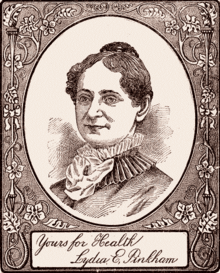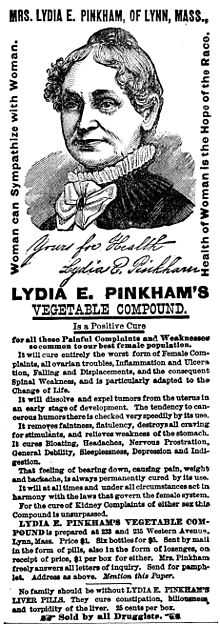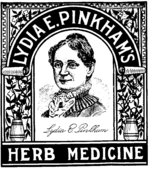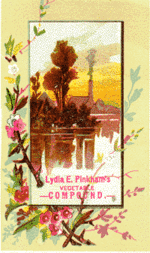Lydia Pinkham
| Lydia E. Pinkham | |
|---|---|
 Lydia E. Pinkham (from a 1904 pamphlet) | |
| Born |
Lydia Estes February 9, 1819 Lynn, Massachusetts |
| Died | May 17, 1883 (aged 64) |
Lydia Estes Pinkham (February 9, 1819 – May 17, 1883) was an iconic concocter and shrewd marketer of a commercially successful herbal-alcoholic "women's tonic" meant to relieve menstrual and menopausal pains.
Biography
Lydia Pinkham was born in the manufacturing city of Lynn, Massachusetts, the tenth of the twelve children of William and Rebecca Estes. The Estes were an old Quaker family tracing their ancestry to one William Estes, a Quaker who migrated to America in 1676, and through him to the thirteenth century Italian House of Este. William Estes was originally a shoemaker but by the time Lydia was born in 1819, he had become wealthy through dealing in real estate and had risen to the status of "gentleman farmer"[1] Lydia was educated at Lynn Academy and worked as a schoolteacher before her marriage in September 1843.[2]
The Esteses were a strongly abolitionist and anti-segregation family. The fugitive slave and abolitionist leader Frederick Douglass was a neighbor and a family friend. The Estes' household was a gathering place for local and visiting abolitionist leaders such as William Lloyd Garrison. The Esteses broke from the Quakers over the slavery issue in the 1830s. Lydia joined the Lynn Female Anti-slavery Society when she was sixteen. In the controversies which divided the abolitionist movement during the 1840s, Lydia would support the feminist and moral persuasion positions of Nathaniel P. Rogers.[3] Her children would continue in the anti-slavery tradition.[4]
Isaac Pinkham was a 29-year-old shoe manufacturer when he married Lydia in 1843. He would try various businesses without much success. Lydia gave birth to their first child, Charles Hacker Pinkham, in 1844. She lost their second child to gastroenteritis, but gave birth to their second surviving child, Daniel Rogers Pinkham, in 1848. A third son, William Pinkham, was born in 1852, and a daughter, Aroline Chase Pinkham, in 1857.[5] All the Pinkham children would eventually be involved in the Pinkham medicine business.
Like many women of her time, Pinkham brewed home remedies which she continually collected. Her remedy for "female complaints" became very popular among her neighbours to whom she gave it away. One story is that her husband was given the recipe as part payment for a debt,[6] Whatever truth may be in this, the ingredients of her remedy were generally consistent with the herbal knowledge available to her through such sources as John King's American Dispensary, which she is known to have owned and used.[4] In Lydia Pinkham's time and place the reputation of the medical profession was low. Medical fees were too expensive for most Americans to afford except in emergencies, in which case, the remedies were more likely to kill than cure. For example, a common "medicine," calomel, was in fact not a medicine, but instead a deadly mercurial toxin, and this fact was even at the time sufficiently well known among the sceptical to be the subject of a popular comic song.[7] In these circumstances, there is no mystery why many preferred to trust unlicensed "root and herb" practitioners, and especially to trust women who were prepared to share their domestic remedies, such as Lydia Pinkham.[8]
Isaac Pinkham was ruined h was permanently broken under the associated stress.[9] The fortunes of the Pinkham family had long been patchy, but they now entered on hard times. Lydia sometimes accepted payment for her popular remedy for female complaints. It is reputed to have been her son Daniel who came up with the idea, in 1875, of making a family business of the remedy. Lydia initially made the remedy on her stove before its success enabled production to be transferred to a factory. She answered letters from customers and probably wrote most of the advertising copy.[10] Mass marketed from 1876, on, Lydia E. Pinkham's Vegetable Compound became one of the best known patent medicines of the 19th century. Descendants of this product are still available today. Lydia's skill was in marketing her product directly to women, and her company continued her shrewd marketing tactics after her death. Her own face was on the label, and her company was particularly keen on the use of testimonials from grateful women.
Advertising copy urged women to write to Mrs. Pinkham. They did, and they received answers. They continued to write and receive answers for decades after Pinkham's own death. These staff-written answers combined forthright talk about women's medical issues, advice, and, of course, recommendations for the company product. In 1905, the Ladies' Home Journal published a photograph of Lydia Pinkham's tombstone and exposed the ruse. The Pinkham company insisted that it had never meant to imply that the letters were being answered by Lydia Pinkham, but by her daughter-in-law, Jennie Pinkham.
Although Pinkham's motives were economic, many modern-day feminists admire her for distributing information on menstruation and the "facts of life," and they consider her to be a crusader for women's health issues in a day when women were poorly served by the medical establishment. The Lydia Pinkham House, located near her factory on Western Ave in Lynn, Massachusetts was placed on the National Register of Historic Places September 25, 2012. In 1922, Lydia's daughter Aroline Pinkham Chase Gove founded the Lydia E. Pinkham Memorial Clinic in Salem, Massachusetts to provide health services to young mothers and their children. The clinic has been controlled since 1990, by Stephen Nathan Doty, a fourth generation descendant of Lydia, who also uses the memorial building as his personal residence. The clinic is in operation as of 2013. It is designated Site 9 of the Salem Women's Heritage Trail.[11][12]
Lydia E. Pinkham's Vegetable Compound

The five herbs contained in Lydia Pinkham's original formula are:
- Pleurisy root is diaphoretic, anti-spasmodic, carminative, and anti-inflammatory.
- Life root is a traditional uterine tonic, diuretic, anti-inflammatory, and emmenagogue used for amenorrhea or dysmenorrhea.
- Fenugreek is vulnerary, anti-inflammatory, anti-spasmodic, tonic, emmenagogue, galactogogue, and hypotensive.[13]
- Unicorn Root was used by several Native American tribes for dysmenorrhea, uterine prolapse, pelvic congestion and to improve ovarian function.[14]
- Black cohosh is an emmenagogue, anti-spasmodic, alterative, nervine, and hypotensive and is used traditionally for menopausal symptoms.[13]
The formula also contains drinking alcohol, ethanol, as in wine, beer and liquor of all sorts. Alcohol relieves muscular stress and acts as a pain killer, and also changes one's mood.
Of the newer additions, motherwort is claimed to be a nervine, emmenagogue, anti-spasmodic, hepatic, cardiac tonic, and hypotensive. Piscidia erythrina (Jamaican dogwood) is claimed to be an eclectic remedy that is claimed to have been found effective for painful spasms, pelvic pain, dysmenorrhea and ovarian pain.[14] Licorice is claimed to be anti-inflammatory, anti-hepatotoxic, anti-spasmodic and a mild laxative. Gentian is claimed to be a, sialagogue, hepatic, cholagogue, anthelmintic, and emmenagogue. Dandelion is an insecticide but is claimed to be potassium-sparing diuretic, hepatic, cholagogue, anti-rheumatic, laxative, tonic, and a bitter.[13]

It is often suggested by the alternative medicine community that black cohosh (and a purified version, Remifemin) really do provide relief from symptoms of menopause. A report by the Natural Standard, which performs evidence-based reviews of alternative therapeutics, says:
Black cohosh is a popular alternative to prescription hormonal therapy for treatment of menopausal symptoms such as hot flashes, mood problems, perspiration, heart palpitations, and vaginal dryness. Initial human research suggests that black cohosh may improve some of these symptoms for up to six months. However, most studies are not well designed and results are not conclusive.
The report gives the evidence a "B" rating, "good scientific evidence for this use."


However, the National Institutes of Health performed a "...12-month randomized, double-blind, placebo-controlled trial, compared several herbal regimens and menopausal hormone therapy (estrogen with or without progesterone) to placebo in women ages 45 to 55... Newton and colleagues found no significant difference between the number of daily hot flashes and/or night sweats in any of the herbal supplement groups when compared to the placebo group."[15]
In a day when the mainstream treatment of these conditions was sometimes surgical removal of ovaries—with a mortality rate of 40%—it can be argued that at the very least Pinkham's remedy followed the sound medical principle of "first, do no harm."
However, many of the ingredients have been traditionally used by a number of unrelated Indian tribes, in Chinese medicine and in western medicine, which gives credence to at least some relief being actively given even if double blind tests have not been done to confirm their usefulness. The persistence of Mrs. Pinkham's compound long after her death is testament to its acceptance by women who sought relief from menstrual and menopausal symptoms. The company continued under family control until the 1930s.[16] Although Lydia Pinkham's company continued increasing profit margins fifty years after her death, eventually the advent of the Food and Drug Administration (FDA) caused changes in the formula. The compound is now produced by a pharmaceutical company.
The original product and its modern descendants

The original formula for Lydia Pinkham's Vegetable Compound was:
- Unicorn root (Aletris farinosa L.) 8 oz.
- Life root (Senecio aureus L.) 6 oz.
- Black cohosh (Cimicifuga racemosa (L.) Nutt.) 6 oz.
- Pleurisy root (Asclepias tuberosa L.) 6 oz.
- Fenugreek seed (Trigonella foenum-graecum L.) 12 oz.
- Alcohol (18%) to make 100 U.S. pints
As of 2004, Numark Laboratories of Edison, New Jersey markets a similar product named "Lydia Pinkham Herbal Compound". The product is carried by the Walgreens, CVS and Rite Aid. drugstore chains. Ingredients listed in this product are:
- Motherwort (Leonorus cardiaca)
- Gentian (Gentiana lutea)
- Jamaican dogwood (Piscidia erthrina)
- Pleurisy root (Asclepias tuberosa)
- Licorice (Glycyrrhiza glabra)
- Black cohosh (Cimicifuga racemosa)
- Dandelion (Taraxacum officinale).
Time of Your Life Nutraceuticals of St. Petersburg, Florida produces a product named Lydia's Secret for Lydiapinkham.org. Said to be "based on" the original formula, it has these listed ingredients
- Black cohosh root (Cimicifuga racemosa)
- Dandelion root (Taraxacum officinale)
- Pleurisy root (Asclepias tuberosa)
- Chastetree berry (Vitex agnus-castus)
- False unicorn root (Chamaelirium luteum)
- Jamaica dogwood bark (Piscidia erthrina)
- Gentian root (Gentiana lutea)
- Vitamin E
- Vitamin B6
- Magnesium
- Zinc.
Drinking songs
Drinking songs that consist of numerous verses describing the humorous and ribald invigorating effects of some food or medicine form almost a small genre in themselves. The fact that Pinkham's medicine was marketed for "female complaints" made it especially vulnerable to ribald fantasies about what it might cure. Lydia and her "medicinal compound" are memorialized in the folk song "The Ballad of Lydia Pinkham," also known as "Lily the Pink". As folk songs, they have no definitive versions.
A sanitized version of Lily the Pink was a number one hit for The Scaffold in the United Kingdom in 1968/69. The Irish Rovers also released the Scaffold version of the song, in 1969, on the album Tales to Warm Your Mind, and as a single reaching the Top 30 on the US Billboard charts.
This song was further successfully adapted into French in 1969 by Richard Anthony, describing humorously the devastating effects of a so-called "panacée" (universal medicine). One reason that a humble women's tonic could become the subject of such and sundry ribald drinking ballads and an increasing success in the twenties and early thirties was its availability, as a 40-proof patent eye-opener, during Prohibition.
Notes
- ↑ Stage 1979, p. 18
- ↑ Stage 1979, pp. 24–25
- ↑ Stage 1979, pp. 20–24
- ↑ 4.0 4.1 Stage 1979, p. 28
- ↑ Stage 1979, pp. 25–26
- ↑ Stage 1979, pp. 27–28
- ↑ Stage 1979, pp. 49–50. "The man in death begins to groan/The fatal job for him is done;/ He dies, alas! But sure to tell,/ A sacrifice to Calomel," ran a verse from the song by Lydia's neighbours, the Singing Hutchinsons.
- ↑ Stage 1979, p. 53
- ↑ Stage 1979, pp. 31–32
- ↑ Stage 1979, chpt. 1
- ↑ "The self-guided walking trail route of the Salem Women's Heritage Trail". Salem Women's History and Business Community. Retrieved January 30, 2012.
- ↑ Lynch, Jacqueline T (March 6, 2009). "Lydia Pinkham Memorial Clinic - Salem, Mass.". New England Travels. blogspot.com. Retrieved January 30, 2012.
- ↑ 13.0 13.1 13.2 http://www.healthy.net/scr/MMList.asp?MTId=1 David Hoffman Herbal Medicine Materia Medica
- ↑ 14.0 14.1 Brinker, F. A comparative review of eclectic female regulators. Journal of Naturopathic Medicine, Winter, 1997, Vol. 7, (1), pp. 11-26.
- ↑ http://www.nia.nih.gov/NewsAndEvents/PressReleases/PR20061218HALT US National Institutes of Health
- ↑ "Business & Finance: Family Trouble". Time. May 4, 1936.
References
- Stage, Sarah (1979). Female Complaints: Lydia Pinkham and the Business of Women's Medicine. W. W. Norton and Co. ISBN 0-393-00033-8.
- The L.E.Pinkham Medicine Company had its factory and offices on the corner of 267-271 Western Avenue and Cleveland St. See the 1897 Atlas of Lynn, Massachusetts, plate 6. Lower Right side. Click on map for a very large and clear image.
External links
- Historic Lydia Pinkham building official site
- Lydia Pinkham at Encyclopædia Britannica
- Works by Lydia Pinkham at Project Gutenberg
- Works by or about Lydia Pinkham at Internet Archive
- Herbs Used by 19th Century Eclectic Physicians to treat Female Genito-Urinary Conditions Brinker, Francis. A comparative review of eclectic female regulators. Journal of Naturopathic Medicine, Winter, 1997, Vol. 7, (1), pp. 11–26.
- LydiaPinkham.org
- Lydia Pinkham Herbal Compound by Numark Labs
- Advertisement for Lydia E. Pinkham's Vegetable Compound, from an early-1900s cookbook entitled Fruits and Candies
- Letter signed "Mrs Pinkham", received by a woman who wrote to her in 1910.
- Salem Women's Heritage Trail
- Natural Standard Patient Monograph on black cohosh
- WWII B-17 Shot Down 19 December 1943 - Robert D. Peterson Pilot, warplane named "Lydia Pinkham"
- Lydia E. Pinkham Medicine Company. Records, 1776-1968.Schlesinger Library, Radcliffe Institute, Harvard University.
- Newspaper advertisement for Lydia E. Pinkham's Vegetable Compound, from The Daily Evening News, Saint John, N.B., April 17, 1883
- Lily the Pink Sheet Music
|